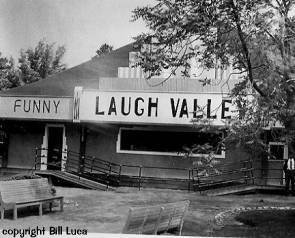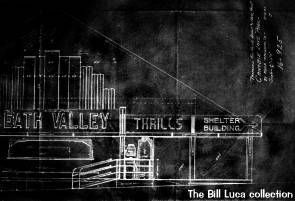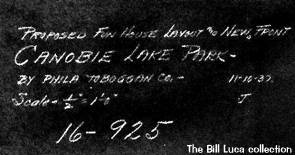

Funhouses and Dark Rides at Canobie Lake
By Bill Luca
 Canobie Lake Park has operated
continuously in Salem, NH since 1902. Although it is more than likely that some form of
funhouses and darkrides existed there in the era of the 1920's and 30's, the only rides of
that type that can be recalled are the walk-thru situated near the picnic grounds and the
ride-thru on the central midway just before the park's 1938 wooden coaster. Canobie Lake Park has operated
continuously in Salem, NH since 1902. Although it is more than likely that some form of
funhouses and darkrides existed there in the era of the 1920's and 30's, the only rides of
that type that can be recalled are the walk-thru situated near the picnic grounds and the
ride-thru on the central midway just before the park's 1938 wooden coaster.The funhouse was built by Philadelphia Toboggan Co. around 1938. It was originally proposed with the name "Death Valley", however the park owners changed this to "Laugh Valley" when construction began. The attraction was a mid-sized typical walk-thru, similar to many others PTC had been building around the country at that time, with a dark twisting maze, shifting floorboards, lily pads and the like. It featured as its central attraction PTC's popular "Magic Carpet", consisting of an upholstered bench sat upon by pairs of patrons and which collapsed at the control of an operator, spilling the patrons onto a wide canvas conveyor belt followed by a second belt which brought the laughing patrons to the exit.  
Click here for a larger blueprint view. In the period of the mid-sixties, "Laugh Valley" was redecorated with an ornate new front and renamed "House of Seven Gables", identifying with the mysterious historic house in neighboring Salem, MA, subject of the novel of the same name by Nathaniel Hawthorne. The funhouse did not receive major internal renovations at this time.
Other traditional funmakers then in operation were a maze constructed of stacked barrels and a tilted room with psychedelic stripes. It was also decided at this time to remove the Magic Carpet. This was replaced with a succession of crooked doorways lit by flashing lights through which patrons passed on a floor which followed the incline of the earlier Magic Carpet conveyors. The House of Seven Gables, like so many other traditional funhouses which served their host parks and patrons so well, was destined to end its life about five years later, when the building was gutted and fitted with a Fascination hall. Still later, and operating to this day, a gift shop and restaurant occupy the building. Canobie Lake was host to an excellent darkride built around 1954 by William Cassidy's Pretzel Amusement Co. This ride was perhaps Pretzel's standard installation for that period, using the recently introduced rotating cars. The front of this ride was relatively low key in decor, as per the park's traditional tasteful family atmosphere. There was a rather mysterious mural painting along the wall behind the car lineup, depicting a devil's head and question marks and befuddled individuals and the sign at the top of the front said simply "Pretzel". Inside was the traditional constantly twisting and turning Pretzel track layout, and most the tricks consisted of the so-called 'black boxes' that Pretzel furnished at that time. These were a series of about a half-dozen wooden boxes which were painted black and contained masks or paper mache heads which had gearmotor-driven mechanisms causing the heads to move back and forth, side to side, etc. These were illuminated with blacklight tubes. This ride was virtually identical to other Pretzel rides built in the early 50's, such as Devil's Den at Old Orchard, Maine and Shangrila Ha Ha! at Steeplechase Park, Coney Island. Around the time Bill Tracy reworked the 7 Gables, he was also engaged by the park to update the Pretzel. Some of the 'black boxes' were removed and Tracy built an elaborate graveyard scene behind the traditional half-inch mesh screen which the cars cruised by. There also was a large spinning spiral bull's eye illuminated, like everything else, with blacklight. The front was completely rethemed and renamed "The Swamp", with a passing resemblance, though much less elaborate, to Tracy's "Journey To The Center Of The Earth" at Dorney Park, PA. As the 80's approached, Canobie's management felt the end of "The Swamp" was in sight. As has happened in other Pretzel spinning car systems, the rotating function was disabled as some patrons complained that the motion was just too disorienting. The friction rails in "The Swamp" would spin the car in one direction then rub the other side and reverse the direction. The wooden building was very dried out and was settling badly.
Another problem was that, since the cars no longer rotated, a number of teenage riders became so familiar with the track layout that they would jump out of the car at a point beyond the graveyard scene at the rear of the building, near the service entrance through which cars would be removed to the repair shop. An alarmed ride operator would see the car emerge empty and have to stop the ride and throw on the emergency lights and search the interior for the lost patron. The thought of a person wandering in the dark and being struck by a very heavy Pretzel car was another vote to close the ride, which finally occurred in the mid 80's. Game concessions now stand where the classic Pretzel thrilled so many thousands of riders over the years.
|
|
 |
 |
 |
 |
| This article is © 1999 by Bill Luca and is used with permission. Laugh Valley, 7 Gables and Swamp photos are from the Bill Luca collection. All other photos are copyright the Laff In The Dark collection. All are used with permission. | |
Contents © 1999 Laff In
The Dark unless otherwise noted. All rights reserved.
Laff In The Dark is not affiliated in any way with the Amusement Parks listed at this site
This page was last updated Sunday, April 11, 1999